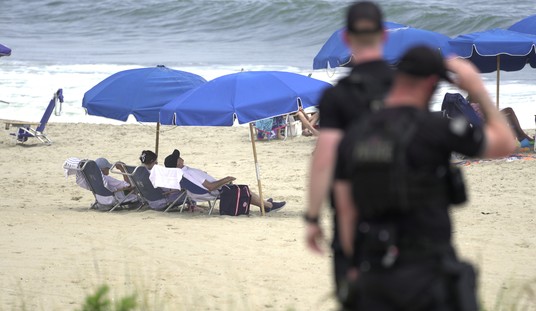Hurricane Ike has emerged in the Gulf of Mexico, having survived its long passage over Cuba relatively intact, and it has a good chance of intensifying into a major hurricane — and aiming for a highly vulnerable part of the Texas coast. According to Dr. Jeff Masters, “There is a significant chance that Ike will be the worst hurricane to hit Texas in over 40 years.”
The standard caveats apply. Landfall in Texas is more than three days away. We don’t know — we can’t know — exactly where Ike will go, how strong it will get, or whether it will maintain its strength all the way to the coast. There are plenty of plausible scenarios which are not “worst case.” The odds do not favor a calamity. They never do, at 72+ hours out. But Ike is a real threat.
This new sense of worry is fueled partly by the track. As I mentioned earlier, the trend toward a landfall in more sparsely populated south Texas or northern Mexico has halted, and now the computer model tracks are inching north — and getting uncomfortably close to the heavily populated, highly vulnerable Houston/Galveston region. In Eric Berger‘s words, “if the models were to shift just 50 or so miles up the coast, a landfall at Freeport or just to the northeast would bring the strongest winds to Houston.”
The new official forecast track brings Ike ashore just north of Corpus Christi, and the National Hurricane Center’s 5:00 PM discussion acknowledges that this may be too far south:
THERE HAS BEEN A SIGNIFICANT NARROWING IN THE SPREAD OF THE LATEST MODEL RUNS…WITH THE GFS…GFDL…AND NOGAPS ALL SHOWING LESS RIDGING TO THE NORTH OF IKE LATE IN THE PERIOD AND SHIFTING THEIR TRACKS NORTHWARD TO BE IN BETTER AGREEMENT WITH THE UKMET AND ECMWF RUNS. IKE IS NOW EXPECTED TO RECURVE AROUND THE PERIPHERY OF THE SUBTROPICAL RIDGE NEAR THE END OF THE FORECAST PERIOD. THE OFFICIAL FORECAST IS ADJUSTED NORTHWARD ON DAYS FOUR AND FIVE…BUT ALL OF THE BETTER DYNAMICAL MODELS ARE EVEN FARTHER TO THE RIGHT.
Translation: if the models don’t lurch back to the left, the NHC’s forecast landfall point will move further away from Corpus Christi and closer to Freeport — the west edge of Houston/Galveston’s “worst-case” landfall zone.
The other reason for alarm is Ike’s failure to fall apart during its on-again, off-again overland trek across Cuba, which has just ended. It took Ike almost 48 hours to traverse the island from end to end, and the storm’s winds diminished from 135 mph a few hours before landfall, and 125 mph at landfall, to 75 mph now. But the storm’s core remains structurally well put-together, which is the key to future strengthening.
This is a crucial difference between Gustav and Ike. Although Gustav’s passage over Cuba was quite brief — just a few hours — the effects of land interaction, combined with wind shear, were enough to significantly disrupt the storm’s central core, delaying rapid intensification until it was too late for Gustav to re-intensify into a monster. By contrast, Ike’s much lengthier passage of Cuba did not have the same effect. According to the National Hurricane Center’s 5:00 PM discussion:
IKE MAINTAINED A FAIRLY WELL ORGANIZED CORE STRUCTURE DURING ITS PASSAGE OVER WESTERN CUBA . . . IT APPEARS THAT THE CORE IS INTACT ENOUGH TO TAKE ADVANTAGE OF SOME VERY FAVORABLE CONDITIONS IN THE GULF OF MEXICO.
Dr. Masters summarizes things even more bluntly:
All indications are that Ike will intensify into a very dangerous major hurricane . . . [S]atellite loops show that Ike has maintained a large, well-organized circulation during its passage of Cuba. The 4 pm EDT center fix from the Hurricane Hunters found a central pressure of 968 mb, which is characteristic of a Category 2 hurricane. Passage over Cuba did not disrupt the storm enough to keep Ike from intensifying into a major hurricane over the Gulf of Mexico.
The barometric pressure issue is particularly interesting. Ike’s pressure just before landfall in Cuba was 945 mb, typical of a borderline Category 3/4 hurricane, which is exactly what Ike was at the time. During the passage of Cuba, the pressure rose “only” to 968 mb, its current value, which is typical of a borderline Category 2/3 hurricane — not the borderline tropical storm/Cat. 1 that Ike actually is. One reason for this, as I understand it, is that Ike has responded to land interaction by spreading out its wind field over a wider area, which (I believe) tends to cause a hurricane to be “weaker,” wind-speed-wise, than its central pressure would normally indicate.
If I’m not mistaken — and here I must add the caveat that I’m not a meteorologist, I just play one on the Internet, so someone please correct me if I’m wrong — it would not be surprising to see Ike “tighten up” a bit over the Gulf, allowing its winds to ramp up to something more typically in line with the low barometric pressure. In other words, Ike might not actually have to “deepen” all that much to become a Category 2 or 3 hurricane.
In any case, assuming Ike does become a major hurricane over the Gulf — which seems likely, given its core’s organization, and given that both the Loop Current and a Loop Current Eddy stand between it and Texas — the big question is whether, and how much, it will then weaken before making landfall.
Alan Sullivan (who, like me, is an amateur weather buff, not a meteorologist) foresees substantial weakening:
[Ike’s track will take it] into a zone of shear, cooler water, and interaction with an approaching cold front. Such a scenario could yield very heavy rains, but it would not be likely to put a major hurricane ashore. Ike would weaken.
But Dr. Masters, who is a meteorologist (indeed, the co-founder of Weather Underground), is less confident of such an eventuality:
The wind shear for Friday has changed, and we are expecting wind shear to remain around 15 knots, which is still low enough to allow intensification. There is much higher oceanic heat content off the Texas coast than was present off the Louisiana coast for Gustav. Thus, it is more likely that Ike will be able to maintain major hurricane status as it approaches the coast. . . . Given the impressive appearance of Ike on satellite imagery, and the forecasts of high heat content and low shear along its path, I would be surprised if Ike hit as anything weaker than a Category 2 hurricane with 100 mph winds. Here’s my rough probability break-down for Ike’s strength at landfall, I forecast a 50% chance Ike will be a major hurricane at landfall:
Category 1 or weaker: 20%
Category 2: 30%
Category 3: 30%
Category 4 or 5: 20%
A major-hurricane landfall anywhere along the middle Texas coast would be a very bad thing, as Dr. Masters points out with his explanation of why “Texas is highly vulnerable to storm surge.” But nowhere is the threat greater than in Houston/Galveston, as this 2005 article by Berger explains in detail:
Houston’s perfect storm would feed on late summer’s warm waters as it barreled northward across the Gulf of Mexico, slamming into the coast near Freeport.
A landfall here would allow its powerful upper-right quadrant, where the waves move in the same direction as the storm, to overflow Galveston Bay. Within an hour or two, a storm surge, topping out at 20 feet or more, would flood the homes of 600,000 people in Harris County. The surge also would block the natural drainage of flooded inland bayous and streams for a day or more.
Coastal residents who ignored warnings to flee would have no hope of escape as waters swelled and winds roiled around their homes. Very likely, hundreds, perhaps even thousands, would die.
Meanwhile, as the storm moved over western Harris County, its most dangerous winds, well in excess of 120 mph even inland, would lash the Interstate 45 corridor, including Clear Lake, the Texas Medical Center and downtown.
Many older buildings could not withstand such winds.
Anything not tied down, from trees to mobile homes to light poles, would become missiles, surreally tumbling and flying through the air, flattening small houses, shattering skyscraper windows and puncturing roofs.
“Unfortunately, we’re looking at massive devastation,” said Roy Dodson, president of the engineering firm Dodson & Associates, which Harris County asked to model realistic “worst-case scenarios” for a major hurricane hitting the area.
Dodson’s firm modeled more than 100 storms of varying power, speed and landfall. It concluded that a large Category 4 or Category 5 . . . would cause as much as $40 billion to $50 billion in damage.
Now, before anyone accuses me of “hype,” please re-read the second paragraph of this post. The odds do not favor a calamity. But a worst-case scenario, or something close to it, is now a realistic possibility, albeit one that’s far from certain. Texas residents need to watch this storm very closely, and not be lulled into a false sense of security by previous false alarms (Rita, Edouard, etc.). Ike could be the real deal. Maybe it won’t be — but it could be.
Berger, circa 2008, says of Ike: “The bottom line is that the Houston area could face a near worst-case scenario with Ike, although I’d still peg the chances of this happening at one-in-four, or less.” He is, I believe, including any major hurricane landfall (Cat. 3 or above, not just Cat. 4 or 5) hitting between Freeport and Galeveston in his “near worst-case” category.
Dr. Masters, for his part, spells out “a realistic worse-case scenario for Texas”:
There is a significant chance that Ike will be the worst hurricane to hit Texas in over 40 years. The latest run of the HWRF and GFDL models paint a realistic worst-case scenario for Texas. These models bring Ike to the coast as a Category 4 hurricane (which I give a 20% probability of happening). The HWRF predicts a 170-mile stretch of coast will receive hurricane force winds of 74 mph or greater. A 100-mile stretch of coast will receive winds of Category 3 strength and higher, 115 mph. Hurricane force winds will push inland up to 50 miles, along a 50-mile wide region where the eyewall makes landfall. A 100-mile stretch of Texas coast will receive a storm surge of 10-15 feet, with bays just to the right of where the eye makes landfall receiving a 20-25 foot storm surge. This is what Hurricane Carla of 1961 did to Texas. Carla was a Category 4 hurricane with 145 mph winds at landfall, and drove a 10 foot or higher storm surge to a 180-mile stretch of Texas coast. A maximum storm surge of 22 feet was recorded at Port Lavaca, Texas. Despite the fact that the center of Carla hit over 120 miles southwest of Houston, the hurricane drove a 15-foot storm surge into the bays along the south side of the city.
Bottom line: for folks in Texas, it is not time to panic, but it is time to prepare. Determine, if you don’t know already, whether you’re in an evacuation zone. The rule of thumb is “run from the water, hide from the wind,” so unless you’re in a storm surge zone, a flood plain, a poorly constructed home, or quite close to the shore, you can, and probably should, plan to hunker down rather than get the hell out. But don’t listen to me — listen to your local authorities. And if you are in an evacuation zone, make the necessary preparations to leave tomorrow or Thursday, if and when the order comes.
Again, listen to the local authorities on this: if they tell you to leave, you should leave. Ike is nothing to trifle with. As I’ve said, it may, for a variety of reasons, prove to be something less than a disaster — and if this happens, it will not mean the storm was “overhyped,” it will just mean you got lucky. Be grateful, if so. But you should not play Russian roulette with this storm. Yes, previous hurricanes have made lucky turns. Yes, last-minute weakening often happens, and is possible here. But those fortuities are not guaranteed. Take Ike seriously.









Join the conversation as a VIP Member